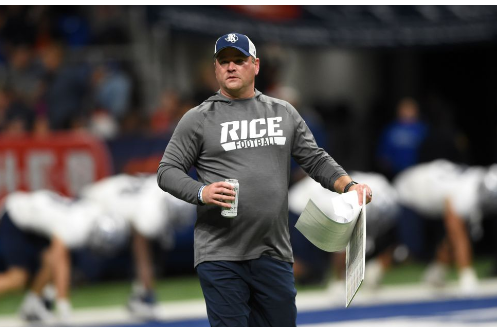Lavonte Johnson, the highest-rated recruit in Owl history, is the centerpiece of Mike Bloomgren’s seventh class at Rice.
:no_upscale()/cdn.vox-cdn.com/uploads/chorus_asset/file/25273835/1674163930.jpg)
A significant day in the lives of several collegiate athletes throughout the nation occurred on Wednesday, February 7. College football clubs still utilize that Wednesday in February to complete their yearly recruiting classes, even if National Signing Day has lost part of its allure because of the early signing period in December.
Under head coach Mike Bloomgren, the Rice Owls have officially signed 23 players to their 2024 class, which makes up their sixth recruiting class overall. Of the twenty-three, seven were transfers, and three came from the FBS level. The most notable of them was quarterback E.J. Warner, the son of Hall of Fame quarterback Kurt Warner and a two-year starter at Temple.
The remaining sixteen were high school prospects, fifteen of whom were from Texas and one from Arkansas. Eight high school prospects were accepted into the early signing class in December, and on National Signing Day in February, another eight became members of the Rice family. Clearly, Bloomgren and the Owls placed a significant priority on developing locally, as seen by the fact that seven of the eight high school prospects from National Signing Day were from Houston.
When the year began, Rice was still functioning as a Conference USA lame duck, with plans to transfer to the American Athletic Conference on July 1, 2023. The Owls have not only experienced an AAC season, but they have also experienced an AAC season of triumph. Rice had an explosive start to its new conference affiliation, winning six games for the first time since 2014 and posting a.500 record in league play while facing a more difficult schedule than it had in its previous league. Joining the AAC has undoubtedly helped the Owls attract more players.
“We may be able to speak with people who are even better, but I’m not sure if it’s fair to say (our recruiting strategy) has changed,” Bloomgren remarked. From the top to the bottom of this class, it is true. I’m not sure whether we could have had these discussions prior to the AAC. During a coaches’ meeting, one of our associate ADs mentioned that during our first five years here, we participated in ten games that were shown nationally on television. We played nine games on national television this year, if you include the bowl game. You just said how much more cache it is to play against well-known clubs; that alone increases our appeal to recruits.
Even though Rice is enjoying its newfound AAC life, its fiercest foe is still outside the league. The Owls and Houston Cougars battle it out for the Bayou Bucket almost every season in an attempt to become the largest team in the fourth-largest city in the US. In addition to their rivalry on the football field, the two schools—which are the closest in proximity in the FBS, just behind Georgia Tech and Georgia State—have a rivalry on the recruiting field. Rice uses the rivalry as a selling point to attract local recruits, especially after the Owls won the Bayou Bucket for the first time in 13 years last September. Rice saw seven of its eight National Signing Day prospects come from Houston.
The Bayou Bucket was undoubtedly one of the first things recruits saw when they entered our facility for their visit, according to Bloomgren. We discussed how both hideous and wonderful it was. It means a lot, in my opinion, to even see it and watch the highlights video of us playing well versus that team across town.
history’s highest-rated recruit
Mike Bloomgren has brought in the three highest-rated recruiting classes in Rice history over the past three seasons. Better recruits follow logically from better classes. On National Signing Day, the Owls officially signed 3-star safety Lavonte Johnson from Houston’s North Shore High School, making him their highest-rated recruit of the ratings era. Johnson was recruited thanks in large part to a relationship on Rice’s staff; this was a significant commitment for the Owls.
Regarding the recruitment process for Johnson, Bloomgren remarked, “I can mention one name and that will make sense to anybody else who follows high school football, and that’s (Rice linebackers coach) John Kay.” “John didn’t coach him at North Shore, but he did coach his dad,” the man who spent nine seasons as a coach at North Shore before joining Rice’s staff in 2023, said. They had a close friendship because his father was employed by John for a while. There was a lot of trust.
Johnson had offers from at least fifteen FBS schools, including the SEC, Big Ten, and Big 12. He was the 110th-ranked player in the state of Texas, one of the well-known recruiting hotbeds, and the 70th-ranked safety in the 2024 class according to 247Sports. With 62 tackles, two sacks, and 14 passes defended at the conclusion of his senior year, Johnson—a 6’2″, 180-pound safety—deserved to be named to the second team all-district.
“We recently brought him here and had the opportunity to show him everything we have to offer both on and off the field,” Bloomgren stated. Without these interactions, there is no opportunity for you to produce a child like that.
Previously, safety Gabe Taylor, a signee from Miami, Florida in the 2020 class, was Rice’s top-rated prospect. Taylor took part in senior day activities in November, but it is anticipated that he will continue his collegiate career and return for the 2024 campaign, when he will be able to coach and play with Johnson in that role.
Growing and constructing naturally
The postseason format of college football, conference realignment, growing use of the transfer portal, and NIL are just a few examples of the ways in which the sport is changing quickly. Coaches need to adjust with the times and implement new roster-building tactics since all of these developments have an influence on recruitment and program development.
There are several approaches to creating successful programs. For example, Dabo Swinney has assembled a club that consistently contends for ACC titles and has been in the final AP Top 20 for 12 straight seasons, despite Clemson seldom bringing in transfers. Conversely, under first-year head coach G.J. Kinne, Texas State made history by qualifying for its first-ever bowl game last December. Kinne drew almost all of his starting lineup via the transfer portal. While most programs fall into a happy medium, individual coaches have different approaches that work best for them. Rice’s 2024 recruiting plan goes closer toward the Clemson end of the spectrum.
“Bloom, college football is a junior and senior sport,” said Willie Shaw, the father of former Stanford head coach David Shaw, to me. You have the opportunity to accomplish some really amazing things when you can grow old with those men and share your experiences, lessons learned, and program-building essentials,” stated Bloomgren.
Rice’s recent ascent to bowl eligibility has been largely attributed to transfers, as prominent players like Luke McCaffrey and JT Daniels brought their skills from elsewhere to Houston, Texas. But, the Owls decided to focus mostly on high school recruiting and only signed three FBS transfers in the 2024 class.
Rice lost less transfers this offseason than any other FBS club, which is the main reason why no new transfers were added in the 2024 cycle. The only other Rice player to play on the field in 2023 and pledge to Texas Tech is starting defensive lineman De’Braylon Carroll, who will play somewhere else in 2024.
“This class isn’t very transfer-heavy,” stated Bloomgren. That’s a result of our culture, these kids’ affection for one another, and their desire to remain here. We had one player from the previous year’s squad join the portal, which is the least number of kids in America. We most likely would have taken ten more transfers and definitely more from the FBS level if we had lost ten.
There aren’t many transfers needed for Rice’s program to take on starting positions when it plays Sam Houston on August 31, 2024. With a group that is already well-established, the Owls produce more than nearly any other FBS club.
Bloomgren stated, “We return eight starters on offense and ten starters on defense.” “We return 21 of our top 22 players among those ten starters on defense. I have never participated in something like in high school, college, or the professional ranks. Even while such developments are really thrilling, ultimately that explains why there weren’t as many FBS transfers.

